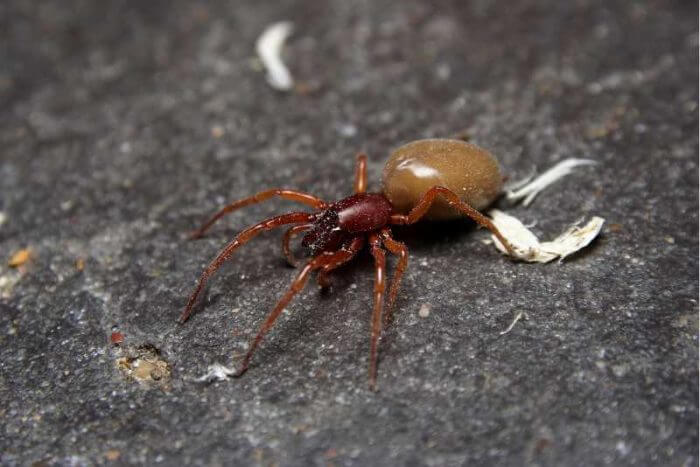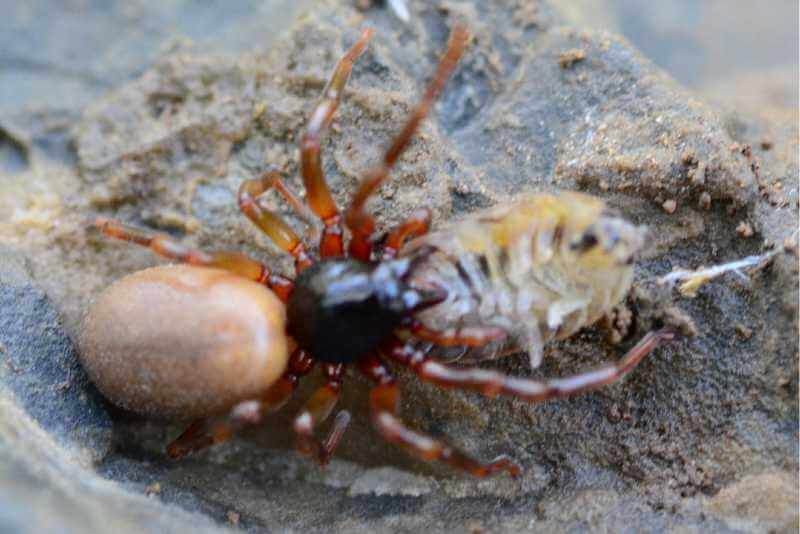Have you ever seen a spider scuttling around your garden, with long and spindly brown legs? If so, you may have just encountered a woodlouse spider! These peculiar-looking arachnids are found all over the world and are distinguished by their unusual coloration.
However, what makes these spiders different to all the rest is not only their unusal color “but” their diet “what they eat”. So in this blog post, we’ll talk about what makes the woodlouse spiders so unique from their distinctive diet, to how they survive in the wild, and more.
So, What Is A Woodlouse Spider?
The Woodlouse Spider, scientifically known as (Dysdera crocata), is a species of spider that primarily preys upon woodlice. This spider has a fascinating history that traces back to the Mediterranean region where this spider first originated.
However, over time, their distribution has become cosmopolitan, meaning these spiders can now be found in various parts of the world.
In North America, the Woodlouse Spider has become common throughout the United States and southern Canada, showcasing its adaptability to different climates and environments.
Interestingly, the spider’s name reflects its dietary preference which is woodlice” getting the name the woodlouse spider!

But, despite their somewhat menacing appearance, woodlouse spiders can actually help in controlling populations of woodlice and other small invertebrates that can be pests in homes and gardens.
Physical Characteristics
The Woodlouse spider is a small spider, measuring approximately 11 to 15mm in length for the females, and the males is around 9 to 10mm. The spider’s color including their legs ranges from reddish-brown to gray, and its cephalothorax (the fused head and thorax) is often darker than the abdomen.
They also have a very large chelicerae considering how small they are, which are often darker in color compared to the rest of their body.
However, unlike other spiders, the Woodlouse spider’s have six eyes rather than the typical eight eyes that most other spiders have.
One of the most distinctive features of this spider is its prominent jaws, which are designed to pierce the hard exoskeleton of woodlice.
Behavior
Woodlouse spiders are nocturnal spiders, meaning they are active during the night, and prefer damp and dark environments like under rocks, logs, and leaf litter. This spider is not web-building nor is it aggressive, but it is an excellent hunter.
It preys on insects, other arachnids, and even other spiders. However, one of the Woodlouse spider’s most remarkable behaviors is that it preys on woodlice, a type of crustacean that most arachnids usually avoid eating.
Habitat
Dysdera crocata is native to the Mediterranean. However, today, it can be found all around the world, from temperate climates to subtropical areas. It is usually discovered in gardens, under stones and bark, where the soil remains damp.
Though not common, this spider also occasionally appears in homes and other buildings.
Diet And Hunting Techniques
When it comes to the woodlouse spiders, hunting techniques they are actually very simliar to the wolf spider and jumping spider. But their diet, of course, is what makes them unique! Although they do still eat some prey that other spiders eat from time to time.
Prey
While the woodlouse spider primarily targets woodlice, they have been known to prey on other small invertebrates when necessary. This includes insects like:
- Silverfish
- Earwigs
- Millipedes
- Burying beetles
- Crickets
- Grasshoppers
However, their hunting techniques and physical adaptations, such as their large fangs are capable of piercing through tough exoskeletons, make them particularly adept at hunting larger type prey.
Hunting Strategy
Woodlouse Spiders don’t create webs to catch their prey, much like the wolf spider, and jumping spider. Instead, they actively hunt for their meals.
The spider’s powerful jaws are designed to pierce the tough armour of woodlice, and they come equipped with two large fangs, the perfect tools to penetrate the defensively covered prey.
Once the spider has immobilized its quarry, it turns the prey using its mandibles to access the softer underparts. Another crucial aspect of their hunting technique is their nocturnal nature.
The cover of darkness provides the Woodlouse Spider with an additional advantage, making them even more effective hunters.

Life Cycle And Reproduction
The life cycle and reproduction of the Woodlouse Spider (Dysdera crocata) are fascinating aspects of this creature’s biology.
Life Cycle
The life cycle of the Woodlouse Spider typically spans two to five years. It starts with the female laying a clutch of eggs, usually between 70 and 100, in a silken sac she creates. Once the eggs hatch, the young spiders, or spiderlings, remain in close proximity to their mother while they grow and develop.
During this growth phase, the spiderlings undergo several molting stages. Molting is a process where they shed their old, outgrown exoskeleton to make way for a new, larger one. This process continues until they reach maturity, which takes about eighteen months from hatching.
Reproduction
The Woodlouse Spider engages in sexual reproduction, which involves the transfer of sperm from the male to the female. The mating season typically occurs in the spring when males seek out females for breeding.
The courtship process can be quite intense, with the male needing to approach the female carefully to avoid being mistaken for prey due to the female’s aggressive nature. After successful mating, the female lays her eggs and encases them in a silk sac for protection.
Unlike many spider species, the Woodlouse Spider exhibits maternal care. The female guards her eggs and newly hatched spiderlings until they’re capable of fending for themselves. This parental care increases the chances of survival for the offspring, contributing to the species overall success.
Venom And Silk
So for years, these spiders have captivated us with their unique diet and hunting technique! But what about their other hidden talents? For example, do woodlouse spiders produce venom and silk like other species of spiders do? or are they something else entirely?
Venom Glands
The Woodlouse Spider is indeed equipped with venom that it basically uses primarily for hunting. Their venom is potent enough to immobilize its primary prey, woodlice. The spider delivers the venom through a pair of robust, oversized fangs, capable of piercing the hard exoskeleton of woodlice.
The venom works quickly to paralyze the woodlouse, allowing the spider to consume its prey without resistance. While the venom is highly effective against woodlice, it poses minimal risk to humans.
In fact, a bite from a Woodlouse Spider can be painful due to the size of the fangs, but the venom itself is not harmful to humans.
Silk Glands
Like many spider species, the Woodlouse Spider produces silk. However, rather than using it to build intricate webs to trap prey, this spider uses its silk in different ways. One primary use is the creation of a silk sac to house its eggs.
This provides a safe and protected environment for the eggs to develop until they hatch.
Additionally, the Woodlouse Spider uses its silk to create retreats or burrows in crevices, under stones, or in leaf litter. These retreats provide a safe place for the spider to hide during the day and also serve as a secure location for molting.
Interaction With Humans
The interaction of the Woodlouse Spider, Dysdera crocata, with humans is generally minimal and non-threatening. These spiders are primarily nocturnal and prefer to stay hidden during the day, meaning that encounters can be infrequent.
When they do interact with humans, it’s typically because the spider has been disturbed or feels threatened. The Woodlouse Spider is not an aggressive species, but it will defend itself if it feels threatened.
It may bite if handled roughly or cornered, but this is not a common occurrence.
Bites And Symptoms
The bite of a Woodlouse Spider, while potentially painful due to their large fangs, is not dangerous to humans. Their venom, which they use to immobilize their prey, does not have a significant effect on human beings.
Symptoms from a bite are usually minor and may include temporary pain, redness, and swelling. These symptoms typically disappear after a short period without requiring medical treatment.
Pest Control
Despite these occasional interactions, Woodlouse Spiders are not considered pests. In fact, they can be beneficial to have around as they help control the population of woodlice and other small invertebrates.
It’s generally recommended to leave these spiders alone if you encounter them. If they’re found inside a home, the best course of action is usually to gently relocate them outdoors where they can continue to contribute to the ecosystem.
Conclusion
So there you have it! Now you know everything about the woodlouse spider! Don’t forget if you want to learn more about spiders and read articles similar to this one, this website is packed with all kinds of content about different spider species. Head over to the home page to find out more!



